The future of technology in art
This article is also available in:
![]() Italiano (Italian)
Italiano (Italian)
I come from an interactive exhibition on Deep Fake in the arts, hosted in the pavilions of the Polytechnic University of Lausanne (EPFL). This Swiss institution, which in 2019 developed the technology for the recognition of “human” deepfakes, is a world-class excellence in the field of science and technology. He wants to help us understand the future of technology in art.
The theme is very topical; digital allows you to create artistic fakes that are almost indistinguishable from the original. But it also allows the use of the works away from their places of origin, to circumvent political or security problems. And it is on this that the organizers have concentrated, to evaluate the ability of a copy to cause lasting emotions over time.
Indice
The tools of technology in art
In a modern exhibition, interactivity is everything. For years I have supported the “museum”, intended as large rooms / parking of objects, dead in most cases. Exceptions are some masterpieces that still today attract thousands if not millions of experts and onlookers for their fame, but this is not the norm. In Switzerland, over 75% of museums do not reach 5,000 visitors a year. But even in Italy, attendance has increased in recent years (excluding the pandemic period). This suggests that we are moving in the right direction to modernize the service offered.
The tools used to add technology to the world of art are mainly touch screens, holograms, mixed, augmented and virtual reality.
Multi-view, or multi-viewer 3D projection
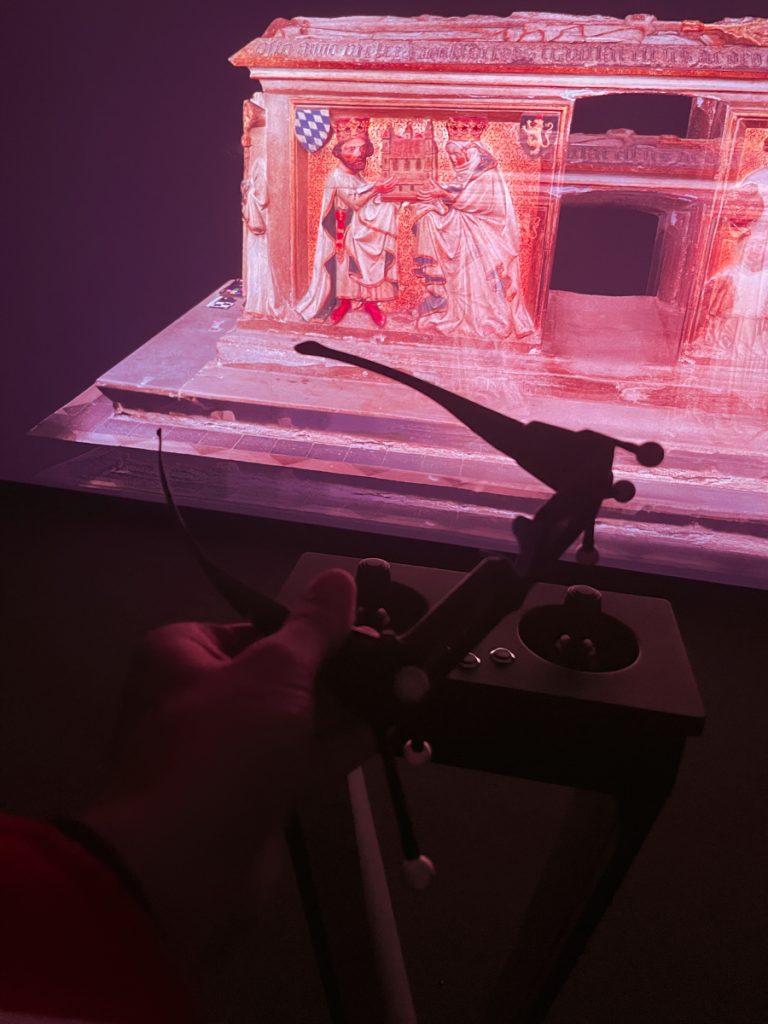
Mea culpa, I was not aware of a beautiful technology: multi-view, or multi-viewer, 3D projection. Operation is simple on paper, albeit technically complex due to the huge amount of data to be processed. A video projector, specifically the Insight 4K HFR 360 (toy worth over $ 300,000), projects 360 frames per second in 4K resolution. This exceptional framerate, combined with active 3D glasses (obviously synchronized with that framerate), allows for the simultaneous reproduction of 3 different stereoscopic videos, giving 60 fps to each single eye.
I tried it and, apart from the inherent discomfort in wearing active glasses for a user of “normal” glasses like me, the vision is perfect.
To further improve the situation, 6DOF tracking (with six degrees of freedom, understands where we are looking and where we are in the room). System similar, if not the same, to those used for the HTC Vive VR headsets (or the old Oculus). In simple terms, the 3D video changes perspective as we move around the room, to achieve the effect of “seeing behind” the projected objects. A change of parallax, copied from virtual reality. And here too, a nice way to add technology to art.
A note on the protagonist: the digitization with laser and scanner techniques of the Abbey of Monte San Michele in Bamburg (Germany). Closed in 2012 to be restored following major structural damage, it can therefore be virtually visited.
Automatic 3D photogrammetry with CultArm3D
In an increasingly automated world, where humans are needed less and less (does this seem like a problem to you?), It is no longer impressive to see a robotic arm photographing a mask far and wide to recreate it in 3D. It’s theCultArm3D.
It is specifically a 3D reproduction of the Samurai mask from the Edo period. And this is the world’s first scanner capable of producing a perfect 3D copy using automatic 3D photogrammetry. Produced by the research of the Fraunhofer Institute for Computer Graphics, of Darmstadt (Germany), it is able to calculate the size of the object, to scan it (even in the case of reflective materials), to recreate it in real time in color in 3D and then to be used in virtual or augmented reality, or printed.
Realistic 3D printing is possible thanks to the development of adaptive color 3D printing. In this specific case, the technologies of the Israeli Stratasys are used. All with a declared goal: to show ancient works without the risk of ruining the originals.
As I see it, well but not very well… Poetry is missing in such an object, and I don’t know how many would substitute it for the true original. The fact remains that in cases other than printing, such a machine allows significant time savings for the digitization of world cultural heritage (and in Italy, there is a lot to do).
Artificial intelligence puts us on the alert
This is what is first imagined when thinking about the future of technology in art. Nice, and at the same time a bit terrifying, Trust AI invites us to sit in front of her, take off the mask so that she can see better and answer her questions.
Her face is a hologram, she informs us of our personal data (age, sex, hair color) and progressively pirates our face until it assumes our appearance. In her speech, after having “stolen” her personality, she is keen to alert us to the data we share online; how these can be used for less than noble purposes by thieves.
Does artificial intelligence cause dangers? Certainly yes, but no more than many other technological innovations. And art installations like this help the public to understand how it works, in order to better defend itself.
The work was produced by Bernd Lintermann and Florian Hertweck at the ZKM | Hertz-Lab, in response to the disturbing spread of deepfakes. I invite you to read the long article in which they describe the project; it’s definitely interesting.
Augmented reality to visit historical monuments
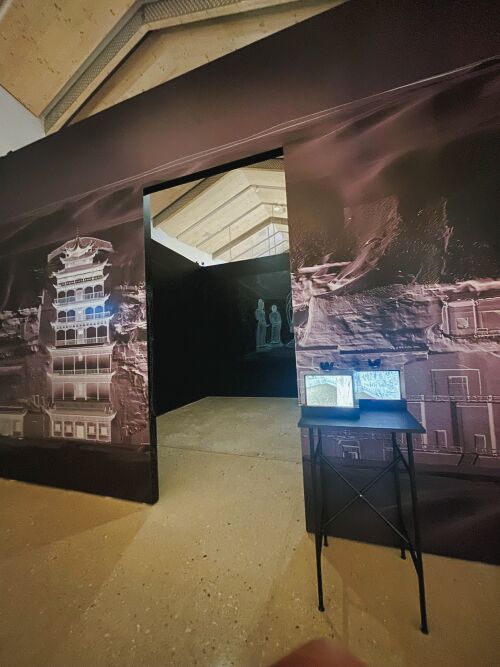
Beautiful, fun for children, but apart from that, visiting a cave reproduced in 3D, displayed in augmented reality with an iPad in hand, I don’t think is the best way to use technology in art. I find it useless, a pure exercise in style; I do not want the creators who have indeed been exceptional.
Mind you, we are talking about one of the Mogao caves, near the city of Dunhaung (China) dating back to the Tang dynasty. Therefore, something very ancient endangered by the excess of tourism. Digital representations are welcome, but this is 100% the field of virtual reality: a trespassing of AR does not produce the same results.
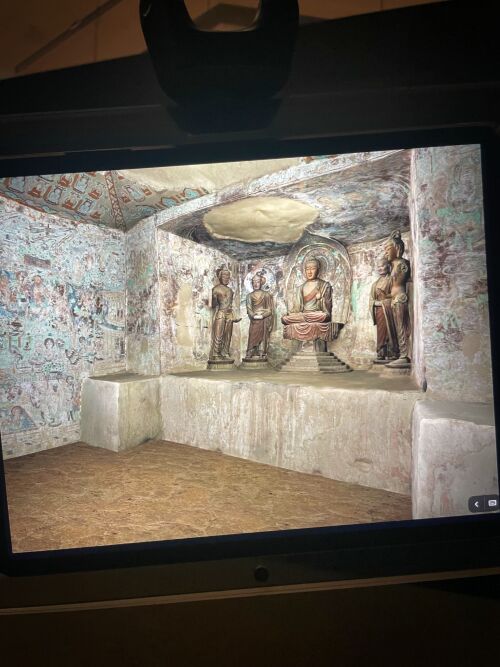
Holding the big tablet in your hand is uncomfortable, to begin with. And since it’s all reconstructed in 3D, why not take advantage of VR to feel like you’re really there, and not walk into a black cube with white textures drawn on the wall?
Augmented reality can really do a lot to improve the quality of a tourist visit, but in the real place. You can get help from an iPad to reproduce life scenes from the past, legends, descriptive videos of a particular point… But a mere virtual visit, let’s do it right.
Augmented reality that makes us think
As soon as you enter the exhibition, two works arouse curiosity. The “Reclining Pan” which we will talk about shortly, and an isolated white pedestal. This is the basis for “The Golden Calf” by Jeffrey Shaw. A calf that takes shape only by pointing the object with an iPad which, thanks to augmented reality, reproduces it.
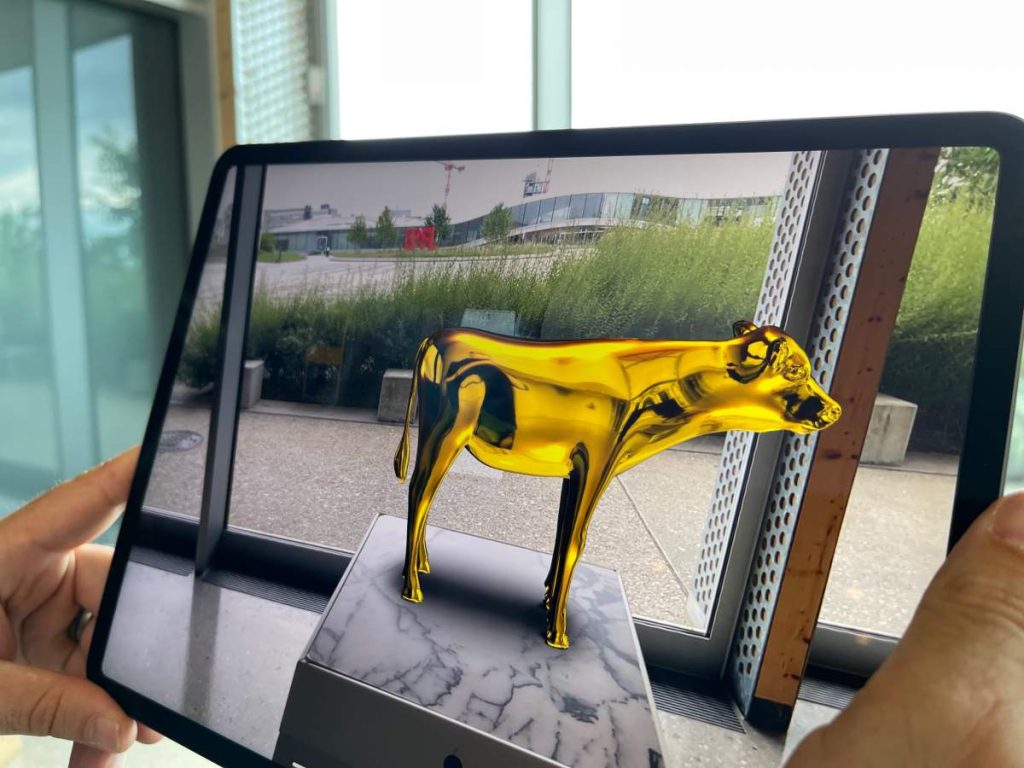
The importance of The Golden Calf is very clear thinking about the year of production: 1994. Shaw was a true pioneer in the world of augmented reality, and obviously in its original form there was not an iPad but a screen equipped with motion tracking. magnetic Polhemus, one of the very few companies to offer this technology at the end of the last century.
The most interesting effect are the reflections on the calf. Four cameras placed on the sides of the pedestal reproduce our image on the subject to give it that extra touch of realism. And to make the work always different, to want to make the viewer himself a co-author. And the calf, elusive, is the object of our desires.
3D printing for the protection of the sculpture
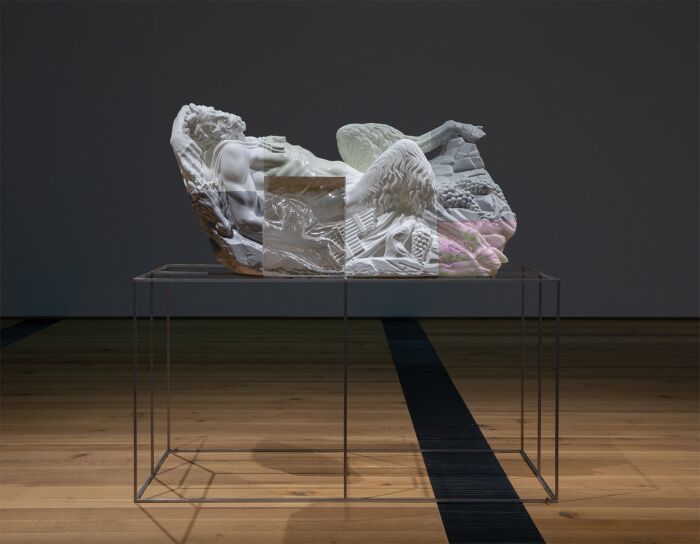
The “Reclining Pan” is the modern copy of an ancient copy. The original work is attributed to the Florentine sculptor Francesco Da Sangallo, built around 1535. In turn, it was a copy of which, however, the original has been lost.
The contemporary artist Oliver Laric made a 3D scan of it (which you can download for free from Three D Scans), then printing it in many different materials. The result is a new, modern, and provocative work. It calls into question the veracity of the post-original in the modern era, rejecting the postulate of the singularity of art and its private property.
Laric, for his popular work, has made many works scanned in 3D available, free of charge, to anyone who wants to download them from the Three D Scans website.
New paths for the future of technology in art
I have not described here all the works, which were over 20. I wanted to talk about those that most of all make us reflect on the changes that technology is bringing to the world of art. In addition to these, it is also worth mentioning the blockchain which here was represented by the multimedia work “89 seconds to Alcázar“, by Eve Sussman. Videos whose rights have been divided into 2,304 “atoms” of 20 × 20 pixels, and sold via blockchain. And whose EPFL reproduction was full of holes, as some atom owners did not consent to free public viewing.
A bright future, in which the public domain will be increasingly important. But at the same time, a future in which artists will have more and more ways to experience their creations, to spread them to the whole world.
In which it will be easier to organize thematic art exhibitions, even in small realities, without the enormous costs of transporting works of great value.
In which spectators will be able to admire and study works of art from all over the world, and from all eras, without the need to travel thousands of kilometers. Which, for heaven’s sake, is beautiful. But sometimes, and for some, impossible.



These new technologies amaze me. To add to these, AI is being used to generate pictures from phrases. I’m sure technology will bring us more exciting art applications in the future.
Yes Jason! It’s really a dynamic sector. I’ve also used in some articles two or three images made by Midjourney, and it’s cool to experiment with the newly public version of DALL·E, DiffusionBee on M1 Mac (based on Stable Diffusion), or AI Picasso on iPhone. The thing that interests us most are certainly the developments in the AI-generated videos sector.
Historical movies will be changed forever by Deep Fakes. One day we will see films with historical characters not cast by actors that look the same. Instead, they will be cast by actors with any background and use the power of Deep Fakes to make them appear the same as the historical figure they portray.